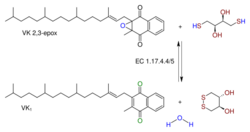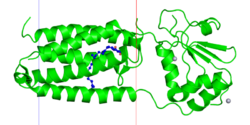Biology:Vitamin K epoxide reductase
| Vitamin K epoxide reductase (warfarin-sensitive) | |||||||||
|---|---|---|---|---|---|---|---|---|---|
 Reaction | |||||||||
| Identifiers | |||||||||
| EC number | 1.17.4.4 | ||||||||
| Databases | |||||||||
| IntEnz | IntEnz view | ||||||||
| BRENDA | BRENDA entry | ||||||||
| ExPASy | NiceZyme view | ||||||||
| KEGG | KEGG entry | ||||||||
| MetaCyc | metabolic pathway | ||||||||
| PRIAM | profile | ||||||||
| PDB structures | RCSB PDB PDBe PDBsum | ||||||||
| Gene Ontology | AmiGO / QuickGO | ||||||||
| |||||||||
| Vitamin K epoxide reductase | |||||||||
|---|---|---|---|---|---|---|---|---|---|
 | |||||||||
| Identifiers | |||||||||
| Symbol | VKOR | ||||||||
| Pfam | PF07884 | ||||||||
| InterPro | IPR012932 | ||||||||
| CATH | 3kp9 | ||||||||
| TCDB | 9.B.265 | ||||||||
| OPM superfamily | 18 | ||||||||
| OPM protein | 3kp9 | ||||||||
| |||||||||
Vitamin K epoxide reductase (VKOR) is an enzyme (EC 1.17.4.4) that reduces vitamin K after it has been oxidised in the carboxylation of glutamic acid residues in blood coagulation enzymes. VKOR is a member of a large family of predicted enzymes that are present in vertebrates, Drosophila, plants, bacteria and archaea.[1] In some plant and bacterial homologues, the VKOR domain is fused with domains of the thioredoxin family of oxidoreductases.[1]
Four cysteine residues and one residue, which is either serine or threonine, are identified as likely active-site residues.[1] Solved bacterial VKOR structures has enabled more insights into the catalytic mechanism. All VKORs are transmembrane proteins with at least three TM helices at the catalytic core. The quinone to be reduced is bound by a redox-active CXXC motif in the C-terminal helices, similar to the DsbB active site. Two other cysteines to the N-terminal are located in a loop outside of the transmembrane region; they relay electrons with a redox protein (or in the case of the bacterial homolog, its own fused domain).[2][3]
The human gene for VKOR is called VKORC1 (VKOR complex subunit 1). It is the target of anticoagulant warfarin. Its partner is a redox protein with an unknown identity,[4][5] probably a thioredoxin-like protein located in the ER lumen such as TMX1.[6]
There is also a similar gene called VKORC1L1. The VKORL1 complex it forms is much less efficient at reducing the epoxide, but it has the ability to reduce the quinone form of vitamin K to a diol form (KH2). Although EC 1.17.4.4 notes both paralogs as having both activities, the precise division of labor in vitro is debated.[7]
References
- ↑ 1.0 1.1 1.2 "Vitamin K epoxide reductase: homology, active site and catalytic mechanism". Trends in Biochemical Sciences 29 (6): 289–92. June 2004. doi:10.1016/j.tibs.2004.04.004. PMID 15276181.
- ↑ "Structure of a bacterial homologue of vitamin K epoxide reductase". Nature 463 (7280): 507–12. January 2010. doi:10.1038/nature08720. PMID 20110994. Bibcode: 2010Natur.463..507L.
- ↑ "Novel insight into the mechanism of the vitamin K oxidoreductase (VKOR): electron relay through Cys43 and Cys51 reduces VKOR to allow vitamin K reduction and facilitation of vitamin K-dependent protein carboxylation". The Journal of Biological Chemistry 286 (9): 7267–78. March 2011. doi:10.1074/jbc.M110.172213. PMID 20978134.
- ↑ "Identification of the gene for vitamin K epoxide reductase". Nature 427 (6974): 541–4. February 2004. doi:10.1038/nature02254. PMID 14765195. Bibcode: 2004Natur.427..541L.
- ↑ "Mutations in VKORC1 cause warfarin resistance and multiple coagulation factor deficiency type 2". Nature 427 (6974): 537–41. February 2004. doi:10.1038/nature02214. PMID 14765194. Bibcode: 2004Natur.427..537R.
- ↑ Schulman, Sol; Wang, Belinda; Li, Weikai; Rapoport, Tom A. (24 August 2010). "Vitamin K epoxide reductase prefers ER membrane-anchored thioredoxin-like redox partners". Proceedings of the National Academy of Sciences 107 (34): 15027–15032. doi:10.1073/pnas.1009972107.
- ↑ "Recent trends in the metabolism and cell biology of vitamin K with special reference to vitamin K cycling and MK-4 biosynthesis". Journal of Lipid Research 55 (3): 345–362. March 2014. doi:10.1194/jlr.R045559. PMID 24489112.
 |

